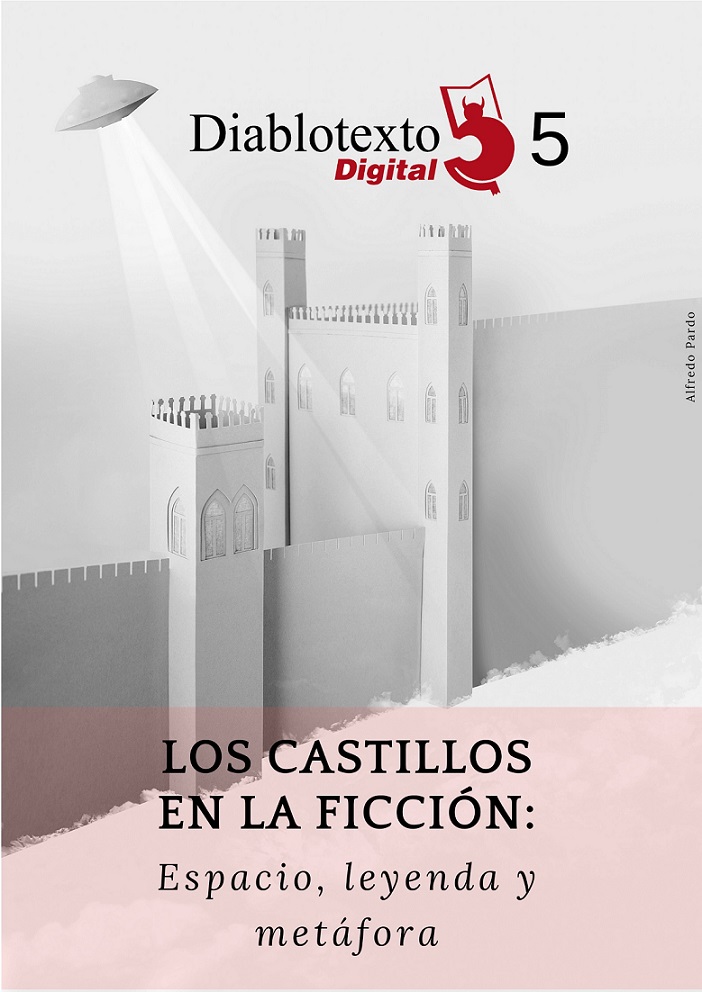Castles, the gothic genre and travel writing: spatial considerations on Washington Irving’s The Alhambra
DOI:
https://doi.org/10.7203/diablotexto.5.13853Keywords:
Castles, Gothic genre, Travel writing, Washington Irving, Alhambra Abstract
Abstract
From the founding moment of the gothic genre, with the (pre)Romantic recovery of medieval imagery, castles have been one of the privileged spaces for terror and the supernatural; particularly, castles located in Southern and Eastern Europe (Spain, Italy, Romania), i.e., in a Catholic, Southern and “peripheric” Europe, one that Romantic travelers visited in order to discover a strange “Other” that was geographically close to them. In this article we will take Washington Irving’s The Alhambra (1832), in particular the chapter “The author’s chamber / The mysterious chambers”, as a starting point to reflect on the crossing between gothic and travel literature, studying the role that space plays in the configuration of both genres.
 Downloads
Downloads
 References
References
Bachelard, Gaston [1958] (2014). The Poetics of space. Nueva York: Penguin Books.
Demata, Massimiliano (2004). “Discovering Eastern Horrors: Beckford, Maturin and the Discourse of Travel Literature”. En Andrew Smith y William Hughes (eds.), Empire and the Gothic. The Politics of Genre. Basingstoke / Nueva York: Palgrave Macmillan, pp. 13-34.
Domínguez, César (2006). “The South European Orient: A Comparative Reflection on Space in Literary History”, Modern Language Quarterly, 67, 4, pp. 419-449.
Gibson, Matthew (2006). Dracula and the Eastern Question. British and French Vampire Narratives of the Nineteenth-Century Near East. Basingstoke / Nueva York: Palgrave Macmillan.
González Alcantud, José Antonio (2011). “Washington Irving en la Alhambra o como construir desde la experiencia etnoliteraria un mito oriental”, Siglo XIX, 17, pp. 215-242.
Heiland, Donna (2004). Gothic and gender. An Introduction. Malden (MA) / Oxford / Victoria: Blackwood Publishing.
Hoeveler, Dianne (2012): “Anti-Catholicism and the Gothic Imaginary: The Historical and Literary Contexts”. En Brett C. McInelly (ed.), Religion in the Age of Enlightenment 3. Brooklyn: AMS Press, pp. 1-31.
Hoeveler, Dianne (2014). The Gothic Ideology: Religious Hysteria and Anti-Catholicism in British Popular Fiction, 1780-1880. Cardiff: University of Wales Press.
Irving, Washington [1832] (1851): Tales of the Alhambra. Nueva York: George P. Putman.
Leersen, Joep (2006): National Thought in Europe. A Cultural History. Amsterdam: Amsterdam University Press.
López Santos, Miriam (2010a). “Ampliación de los horizontes cronotópicos de la novela gótica”, Signa, 19, pp. 273-292.
López Santos, Miriam (2010b). “El género gótico. ¿Génesis de la literatura fantástica?”, en Biblioteca Virtual Miguel de Cervantes, http://www.cervantesvirtual.com/portales/novela_gotica/obra/el-genero-gotico-genesis-de-la-literatura-fantastica/ [Fecha de consulta 18 de enero de 2019]
Ortas Durand, Esther (2005). “La España de los viajeros (1755-1846): imágenes reales, literaturizadas, soñadas…”. En Leonardo Romero Tobar y Patricia Almarcegui Elduayen (eds.), Los libros de viaje: realidad vivida y género literario. Madrid: Akal.
Pratt, Mary Louise. 1992. Imperial Eyes. Travel Writing and transculturation. Londres / Nueva York: Routledge.
Roas, David (2002). “El género fantástico y el miedo”, Quimera, 218-219, pp. 41-45.
Schlegel, Friedrich [1815] (1843). Historia de la literatura antigua y moderna. José Petit de Córdoba (trans.). Barcelona: J. Oliveres y Gavarró.
Staël, Anne Louise Germaine [1813] (1968). De l’Allemagne. París: GF-Flammarion.
Stoker, Bram (1897). Dracula. Nueva York. Grosset & Dunlap.
Walpole, Horace [1764] (1766): The Castle of Otranto. Londres: William Bathor.
Walpole, Horace [1764] (2009). The Castle of Otranto. The Floating Press.
Downloads
Published
How to Cite
-
Abstract753
-
PDF (Español)590
Issue
Section
License
Licencia de reconocimiento de Creative Commons “Reconocimiento - No Comercia l- Sin Obra Derivada
Authors who publish with this journal agree to the following items:
The authors will keep their copyright and guarantee the journal the right of first publication of their work, which will be simultaneously subject to the Creative Commons license that allows third parties to share the work indicating its author and its first publication in the journal. The authors may adopt other non-exclusive license agreements to distribute the version of the published work (e.g., depositing it in an institutional telematic file or publishing it in a monographic volume), with an acknowledgment of its initial publication in this journal. The authors are allowed and encouraged to disseminate their work through the Internet (e.g., in institutional telematic archives or on their website) before and during the submission process, which can produce interesting exchanges and increase citations of the published work. (See Effect of Open Access)




